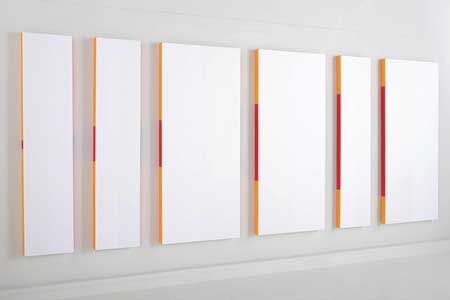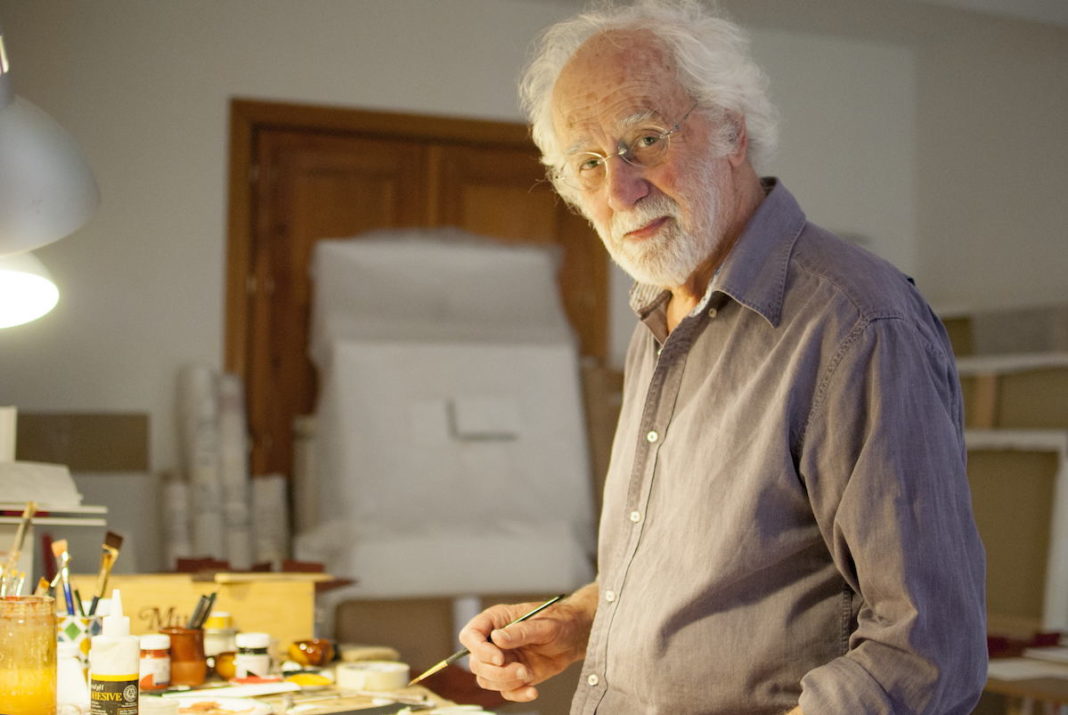César Paternosto

César Paternosto (1931) was born in La Plata, Argentina. He is a painter and sculptor. Since 1967 he lived in New York and in 2004 he moved to Segovia (Spain) where he presented a retrospective exhibition at the Contemporary Art Museum Esteban Vicente with the curatorship of Tomás Llorens. In 1969, Paternosto started a series of white and uniform works and began to paint on the wide edges of the frame.
In 1972, he won the Guggenheim Scholarship. He had numerous solo and group exhibitions both at the United States, as well as in Latin America and Europe. In 2010 the architects Rafael Moneo and Pedro Elcuaz invited him to intervene the lobby of the Atocha Station in Madrid for which the artist ideated an arrangement of colored rectangles that seem to appear and disappear as the traveler or viewer walks by. He recently exhibited at the Museum Thyssen-Bornemisza in Madrid (Spain) at the exhibition called “Towards Painting as Object” that established a dialogue between paintings by the artist and works from the museum’s personal collection (november, 2017- january, 2018).
His works are included in public and private collections such as: the MoMA and the Guggenheim Museum in New York; the Museum of Fine Arts in Boston; the Kunstmuseum Bern, Switzerland, the Art Center National Museum Reina Sofía in Madrid, The Ford Foundation in New York, as well as in the National Museum of Fine Arts, the Museum of Modern Art and the Latin American Art Museum in Buenos Aires. His works also belong to private collections such as the Diana and Bruce Halle Collection, Arizona (USA); the Patrica Phelps Cisneros Collection; the Ella Fontanals-Cisneros Collection, Miami; and the Baroness Carmen Thyssen-Bornemisza and Norman Foster Collections in Madrid (Spain).

Staccato-like, these intervals emphasize the relational quality between the works. Their perception is displaced from the habitual frontal dialogue with the object, viewers are prodded towards a time-transversal reading that restores the visual event as a structural element of the architectural space.
The perception of motion demanded by the work generates the optical effect between planes of color that evolve, appear, and disappear, emphasizing the relational and appropriative quality of the space that typifies this proposal.
This perception, identified with what Paternosto calls “sensitive geometry,” originated in one of his most emblematic works: Staccato (1965, acquired by the Boston Fine Arts Museum in 2008. Staccato is a pictorial symphony based on jazz and tango, where sinuous, undulating color ribbons explore atonality and daring chords that translate into vivid pictorial contrast. The emergence of sensitive geometry in Paternosto’s work corresponds to his formative period in the late 1950s and early 1960s and acts as a countervailing to the strong dominance of the MADI legacy that characterizes geometric abstraction in Argentina at the time.
Established in New York City for over three decades (between 1964 and 2004), Paternosto develops the line of investigation that will characterize his artistic proposal, where the legacy of geometric abstraction in modern art—specifically the emblematic figures of Piet Mondrian and Van Doesburg—are combined with the ancestral traditions of pre-Columbian cultures. The artist made many journeys to the Andean region, restricting his palette to gray and earthen tones during this period.
Also from those years comes his discovery of the “oblique gaze.” Although Paternosto had already pushed the traditional boundaries of the painting to produce canvases with irregular curved outlines, now the center of attention moves from the front to the edges of the canvas, transforming the painting into an object and forcing viewers into a more active reception that demands side-to-side movement to capture the work in its totality.
The influence of his years studying architecture is essential. The paintings, freed from frames and placed at intervals in the gallery wall, behave as a single work of art to which architectural space and light are integrated as constitutive elements. In fact, this artist works his paintings with tungsten light, because this is the light they will receive once they are on display, thus guaranteeing the chromatic efficacy that is so dear to his oeuvre.
The 17 works included in César Paternosto: Painting and Architecture, now on exhibit at Durban Segnini, are articulated into a single work that unfolds, like a ribbon, across space into an evolving symphony where light, color, and rhythm propose a distilled enjoyment of the visual event integrated into the surrounding space.
Works by César Paternosto are part of important collections such as the Museum of Modern Art (MoMA) and the Solomon R. Guggenheim Museum, both in New York City; the Hirshorn Museum & Sculpture Garden, in Washington, D. C.; the Boston Fine Arts Museum; the Museo Reina Sofía in Madrid; the Kunstmuseum, in Bern; and the Museo Nacional de Bellas Artes, among others.
JANET BATET, Artnexus.com













